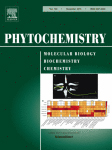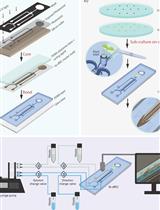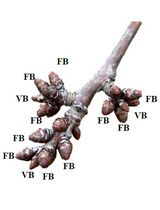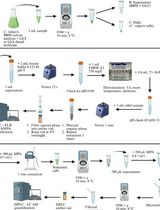- EN - English
- CN - 中文
Determination of Molecular Structures of Condensed Tannins from Plant Tissues Using HPLC-UV Combined with Thiolysis and MALDI-TOF Mass Spectrometry
采用HPLC-UV 结合硫解和MALDI-TOF质谱的方法测定植物组织中缩合单宁的分子结构
发布: 2016年10月20日第6卷第20期 DOI: 10.21769/BioProtoc.1975 浏览次数: 12208
评审: Arsalan DaudiElizabeth LibbyRebecca Van Acker
Abstract
Condensed tannins extracted from plant tissues are suitable substitutes for phenolic resins. Their molecular structure, which might influence their chemical reactivity, can be assessed by the use of both HPLC-UV after acid thiolysis and MALDI-TOF mass spectrometry. Thiolysis of plant extracts in acidic methanol with cysteamine hydrochloride results in the release of the monomeric units of the condensed tannin oligomers that can be further quantified by reversed-phase HPLC-UV by comparison with analytical standards. MALDI-TOF mass spectrometry using 2,5-dihydroxybenzoic acid as matrix and K+ as cationization agent highlights the molecular structural characteristics (e.g., monomeric unit sequence) of the tannin oligomers. The methodologies permit the estimation of the mean and the maximum (observable) degree of polymerization, the type of monomeric units and the presence of glycosylation and/or esterification of the tannin oligomers.
Keywords: Condensed tannins (缩合单宁)Background
Condensed tannins are polyphenolic oligomers made of flavan-3-ol monomeric units that could be extracted from several plant tissues (e.g., softwood barks). They have been recognized as suitable alternatives to synthetic phenolics in resin formulations such as wood adhesives and foamed materials. The most common flavan-3-ol monomers detected in condensed tannins, which differ in the hydroxylation pattern and stereochemistry, are shown in Figure 1.
Figure 1. Most common monomers identified in the structure of condensed tannins
The specific structure of monomeric units in the oligomer and the polymerization degree strongly influence the chemical reactivity and physical properties of the tannins, e.g., condensation reaction rate with aldehydes, heavy metal chelation ability, and viscosity of aqueous solutions (Pizzi and Stephanou, 1994; Yoneda and Nakatsubo, 1998; Garnier et al., 2001). Identification of the molecular structure of the tannins is therefore important to better determine their possible exploitation.
The analysis of the structure of condensed tannins monomers has been performed with different methodologies, e.g., size exclusion chromatography (SEC), normal and reversed-phase high-performance liquid chromatography (HPLC), matrix assisted laser desorption ionization time of flight mass spectrometry (MALDI-TOF MS) and nuclear magnetic resonance (NMR) (Hümmer and Schreier, 2008).
Depolymerisation of tannins in acidic methanol and in the presence of toluene-α-thiol or cysteamine hydrochloride (thiolysis) followed by reversed-phase HPLC-UV was recognised as a suitable method for the estimation of the mean degree of polymerization of condensed tannins and the configuration of their building units (Matthews et al., 1997; Cheynier et al., 2001; Jerez et al., 2007; Bianchi et al., 2015). As well, MALDI-TOF MS has been shown to be successful in the determination of the structure of condensed tannins (Pasch et al., 2001; Monagas et al., 2010; Bianchi et al., 2014).
The proposed method for the analysis of condensed tannins extracted from plant tissues represents an optimization of the previously published procedures for HPLC-UV after acid thiolysis and MALDI-TOF MS. A careful tuning of the mobile phase gradient in the HPLC analysis was performed in order to reach a sufficient separation between the released flavanols and their corresponding thioethers. The choice of the cationization agent in the preparation of the sample for MALDI-TOF MS was also carefully gauged, especially in consideration of samples containing a relatively high amount of inorganic compounds like bark extracts.
The method was successfully used in the characterization of condensed tannins extracted from the bark of softwood species, e.g., Silver fir, European larch, Norway spruce, Douglas fir and Scots pine (Bianchi et al., 2015).
Materials and Reagents
- 1 ml Eppendorf tubes
- 2 ml Eppendorf tubes
- HPLC-filters 17 mm, PTFE, 0.45 µm (infochroma, catalog number: 8817-P-4 )
- Cosmosil Protein-R ø4.6 x 250 mm HPLC column (NACALAI TESQUE, catalog number: 06527-11 )
- Dry extracts from plant tissues (e.g., softwood bark)
The dry plant extracts could be obtained through different processes. For the extraction of tannins, the maceration of fine milled tissue (< 1 mm in size) in solvents like methanol, acetone or water is suggested. The extraction temperature should be between 30 and 90 °C, and the extraction time between 10 and 60 min. The drying of the extract has to be performed avoiding as much as possible post-modification (e.g., oxidation) of the extracts. Vacuum drying and/or freeze-drying are therefore recommended. After drying the extracts should be stored in a refrigerator (3-8 °C), protected from light and air. - Deionized water (18.2 MΩ-cm)
- 2,5-dihydroxybenzoic acid (matrix substance for MALDI MS, HPLC grade) (Sigma-Aldrich, catalog number: 85707 )
- Potassium chloride (KCl) (Sigma-Aldrich, catalog number: P9541 )
- Cysteamine hydrochloride (HPLC grade) (Sigma-Aldrich, catalog number: 49705 )
- Hydrochloric acid (HCl) (37%) (Sigma-Aldrich, catalog number: 320331 )
- Methanol (for HPLC) (Sigma-Aldrich, catalog number: 34860 )
- Acetone (for HPLC) (Sigma-Aldrich, catalog number: 270725 )
- Trifluoracetic acid (TFA) (Sigma-Aldrich, catalog number: 302031 )
- Acetonitrile (ACN) (Sigma-Aldrich, catalog number: 34998 )
- Flavan-3-ol analytical standards:
(+)-Catechin (Sigma-Aldrich, catalog number: 43412 )
(-)-Epicatechin (Sigma-Aldrich, catalog number: 68097 )
(-)-Gallocatechin (Sigma-Aldrich, catalog number: 01338 )
(-)-Epigallocatechin (Sigma-Aldrich, catalog number: 08108 ) - Mass spectra calibration standard covering a range from about 750 to 4000 m/z (e.g., Peptide calibration standard II, Bruker Daltonics, Germany)
- Thiolysis media (see Recipes)
- HPLC mobile phases (see Recipes)
Equipment
- Eppendorf pipette 1-10 µl
- Eppendorf pipette 100-1,000 µl
- HPLC system equipped with a UV-photodiode array detector. In our study an Agilent 1100 LC system was used (Agilent, Waldbronn).
- Water bath (Polyscience, UK)
- Ultrasonic bath (BANDELIN electronic, model: Sonorex RK510 )
- MALDI-TOF mass spectrometer equipped with laser emitting in UV wavelength. In our study a MALDI-TOF mass spectrometer Reflex III was used (Bruker Daltonics, Germany).
- Analytical balance
- Refrigerator
- HPLC vials (1 ml)
Procedure
文章信息
版权信息
© 2016 The Authors; exclusive licensee Bio-protocol LLC.
如何引用
Bianchi, S., Kroslakova, I. and Mayer, I. (2016). Determination of Molecular Structures of Condensed Tannins from Plant Tissues Using HPLC-UV Combined with Thiolysis and MALDI-TOF Mass Spectrometry. Bio-protocol 6(20): e1975. DOI: 10.21769/BioProtoc.1975.
分类
植物科学 > 植物生物化学 > 其它化合物
植物科学 > 植物生理学 > 植物生长
生物化学 > 其它化合物 > 单宁
您对这篇实验方法有问题吗?
在此处发布您的问题,我们将邀请本文作者来回答。同时,我们会将您的问题发布到Bio-protocol Exchange,以便寻求社区成员的帮助。
Share
Bluesky
X
Copy link














